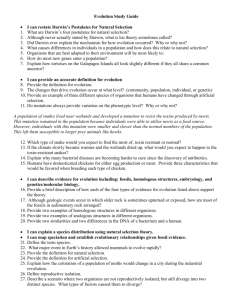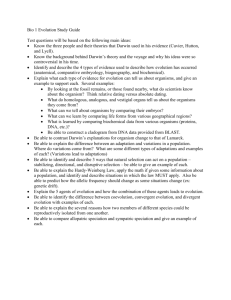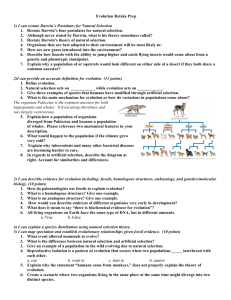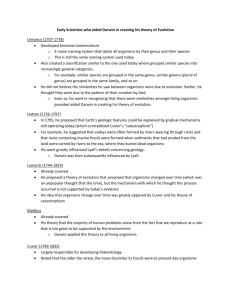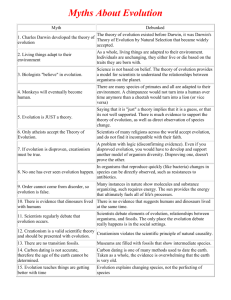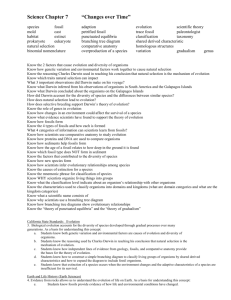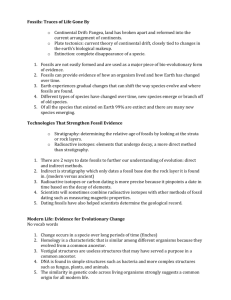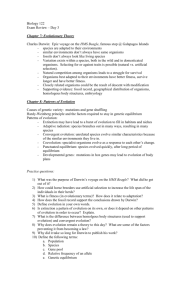History - Integrative Biology
advertisement
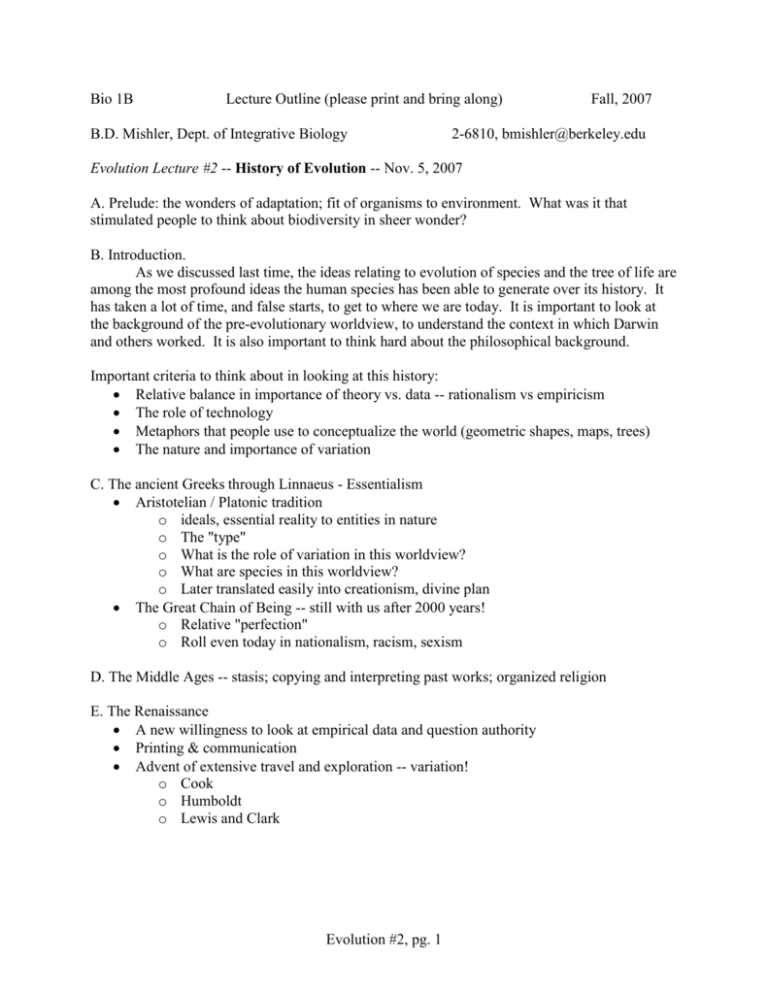
Bio 1B Lecture Outline (please print and bring along) B.D. Mishler, Dept. of Integrative Biology Fall, 2007 2-6810, bmishler@berkeley.edu Evolution Lecture #2 -- History of Evolution -- Nov. 5, 2007 A. Prelude: the wonders of adaptation; fit of organisms to environment. What was it that stimulated people to think about biodiversity in sheer wonder? B. Introduction. As we discussed last time, the ideas relating to evolution of species and the tree of life are among the most profound ideas the human species has been able to generate over its history. It has taken a lot of time, and false starts, to get to where we are today. It is important to look at the background of the pre-evolutionary worldview, to understand the context in which Darwin and others worked. It is also important to think hard about the philosophical background. Important criteria to think about in looking at this history: Relative balance in importance of theory vs. data -- rationalism vs empiricism The role of technology Metaphors that people use to conceptualize the world (geometric shapes, maps, trees) The nature and importance of variation C. The ancient Greeks through Linnaeus - Essentialism Aristotelian / Platonic tradition o ideals, essential reality to entities in nature o The "type" o What is the role of variation in this worldview? o What are species in this worldview? o Later translated easily into creationism, divine plan The Great Chain of Being -- still with us after 2000 years! o Relative "perfection" o Roll even today in nationalism, racism, sexism D. The Middle Ages -- stasis; copying and interpreting past works; organized religion E. The Renaissance A new willingness to look at empirical data and question authority Printing & communication Advent of extensive travel and exploration -- variation! o Cook o Humboldt o Lewis and Clark Evolution #2, pg. 1 Development of the "natural system" of classification o Formalized by Antoine-Laurent de Jussieu (1774), With significant help from Darwin’s friends: Joseph Hooker and Asa Gray o Classification based on multiple features of organisms, subordinates certain characters depending on “importance” What about fossils? o The study of fossils helped to lay the groundwork for Darwin’s ideas o Fossils are remains or traces of organisms from the past, usually found in sedimentary rock, which appears in layers or strata o Paleontology, the study of fossils, was largely developed by French scientist Georges Cuvier o Cuvier advocated catastrophism, speculating that each boundary between strata represents a catastrophe o Gradualism is the contrasting idea that profound change can take place through the cumulative effect of slow but continuous processes o Geologists Hutton and Lyell perceived that changes in Earth’s surface can result from slow continuous actions still operating today - uniformitarianism o This view strongly influenced Darwin’s thinking F. Summary of pre-evolutionary thought: Pre-1750 – Greek philosophy, natural theology ~1750 – Linnaeus – Taxonomy ~1800 – Cuvier – Vertebrate paleontology ~1800 – Hutton – Gradualism ~1830 – Lyell – Uniformitarianism G. Early approaches to evolution Lamarck o Use and disuse o Inheritance of acquired characteristics o “temporalized” the great chain of being Erasmus Darwin (Charlies's grandfather!) H. By the early 1800’s, it was widely speculated that: Earth millions of years old Fossil record shows extinct organisms Similarities between fossil & living organisms Organisms had descended from previously existing ones BUT…two major questions remained: o What mechanism could explain WHY organisms changed through time? o How would organisms be ABLE to change (ie what mechanism of heredity could enable organisms to change)? Answers were given by: o Wallace (to be discussed next lecture...) o Charles Darwin Evolution #2, pg. 2 I. Philosophy of Science -- what is it that makes science science? The history of philosophy: o essentialism o rationalism (went to an extreme in late middle ages) o empiricism (went to an extreme by the 1960's) o modern view is a mixture of the rational and the empirical, with some additions. The modern view: o Ontology -- Background theories stating what kinds of entities exists, what are their fundamental meanings and relationships. [e.g., homologies, phylogenies, species, etc.] o Epistemology -- Background theories stating what kinds of empirical operations and methods can be used to discover the underlying ontological entities and relationships. [e.g., characters, statistics, cladistic analysis, etc.] o Sociology of science -- Motivations; patterns of teaching, cooperating, fighting; "progress" in science (Kuhn, 1970, The Structure of Scientific Revolutions is the classic; see also Hull 1988, Science as a Process). Concepts to discuss: Hypothesis & Prediction Main hypothesis Auxiliary hypotheses Null hypothesis Falsification (the boundary between science and non-science?) Experiment Control Replication Observation versus experiment Historical versus experimental science Cause Model Confidence AH AH H P AH Evolution #2, pg. 3 AH ...
